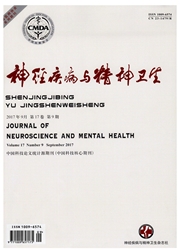

 中文摘要:
中文摘要:
目的 探讨在非典型抗精神病药物利培酮作用基础上联合改良电休克治疗(MECT)或重复经颅磁刺激(rTMS)治疗精神分裂症的疗效及不良反应.方法 将72例精神分裂症患者采用随机数字表法分为MECT组与rTMS组,各36例,分别给予利培酮(起始剂量3 ml/d,最大剂量6 ml/d)联合MECT或rTMS,在治疗1、2、4及8周末,采用阳性与阴性症状量表(PANSS)评定临床疗效,并且在2周末采用不良反应症状量表(TESS)评估不良反应.结果 经过8周治疗后,MECT组与rTMS组的有效率之间(72.22%比63.88%)差异无统计学意义(x2=2.017,P>0.05).两组在治疗前和治疗各阶段PANSS总分及各因子分差异均无统计学意义,在治疗8周末与组内治疗前比较,各项评分均显著下降,差异有统计学意义(P<0.01).治疗2周末时评估,MECT组发生不良反应例数(25例)明显高于rTMS组(18例),两组比较差异有统计学意义(x2=5.808,P<0.05).结论 利培酮联合MECT或rTMS对精神分裂症状的疗效相当,而rTMS治疗的不良反应更少.
 英文摘要:
英文摘要:
Objective To investigate the efficacy and safety of risperidone combined with repetitive transcranial magnetic stimulation(rTMS) or modified electric convulsive therapy(MECT) on the treatment of schizophrenia. Methods Totals of 72 patients with schizophrenia were randomly treated with risperidone plus MECT (MECT group) or risperidone plus rTMS (rTMS group) for 8 weeks ( n = 36 for each group). The initial dose of risperidone was 3 ml/d and the maximal dose was 6 ml/d. The Positive and Negative Syndrome Scale (PANSS) was used to evaluate the efficacy at weekend of 1, 2, 4 and 8, and Treatment Emergent Symptom Scale (TESS) was used to evaluate the adverse reactions at the 2nd week. Results Effective rate in MECT and rTMS was 72.22% and 63.88% respectively, and the difference was statistically significant (x^2 = 2. 017 ,P 〉 0.05). Both the total score of PANSS in both group were decreased significantly with the extension of treatment time, but there were no significant differences between these two groups in each weekend. Compared with that before treatment, the scores were decreased greatly in both groups after treatment (P 〈 0.01). Adverse reactions in treatment 2 weekends occuring in MECT group (25 cases) were significantly higher than those in rTMS group (18 cases), the difference was statistically significant (x^2= 5. 808,P 〈 0.05). Conclusions The efficacy of risperidone combined with rTMS is the same as risperidone combined with MECT, and rTMS show less adverse reactions than that of MECT group.
 同期刊论文项目
同期刊论文项目
 同项目期刊论文
同项目期刊论文
 The effect of citalopram on chronic stress-induced depressive-like behavior in rats through GSK3 bet
The effect of citalopram on chronic stress-induced depressive-like behavior in rats through GSK3 bet Quetiapine add-on therapy improves the depressive behaviors and hippocampal neurogenesis in fluoxeti
Quetiapine add-on therapy improves the depressive behaviors and hippocampal neurogenesis in fluoxeti Gastrodin Ameliorates Anxiety-Like Behaviors and Inhibits IL-1β Level and p38 MAPK Phosphorylation o
Gastrodin Ameliorates Anxiety-Like Behaviors and Inhibits IL-1β Level and p38 MAPK Phosphorylation o Antipsychotics promote the differentiation of oligodendrocyte progenitor cells by regulating oligode
Antipsychotics promote the differentiation of oligodendrocyte progenitor cells by regulating oligode Citalopram alleviates chronic stress induced depression-like behaviors in rats by activating GSK3 be
Citalopram alleviates chronic stress induced depression-like behaviors in rats by activating GSK3 be Electroconvulsive therapy improves antipsychotic and somnographic responses in adolescents with firs
Electroconvulsive therapy improves antipsychotic and somnographic responses in adolescents with firs Sensorimotor gating and memory deficits in an APP/PS1 double transgenic mouse model of Alzheimer&apo
Sensorimotor gating and memory deficits in an APP/PS1 double transgenic mouse model of Alzheimer&apo Anti-depressive mechanism of repetitive transcranial magnetic stimulation in rat: The role of the en
Anti-depressive mechanism of repetitive transcranial magnetic stimulation in rat: The role of the en Quetiapine and repetitive transcranial magnetic stimulation ameliorate depression-like behaviors and
Quetiapine and repetitive transcranial magnetic stimulation ameliorate depression-like behaviors and Gastrodin Alleviates Cerebral Ischemic Damage in Mice by Improving Anti-oxidant and Anti-inflammatio
Gastrodin Alleviates Cerebral Ischemic Damage in Mice by Improving Anti-oxidant and Anti-inflammatio Rosmarinic acid ameliorates PTSD-like symptoms in a rat model and promotes cell proliferation in the
Rosmarinic acid ameliorates PTSD-like symptoms in a rat model and promotes cell proliferation in the Atypical Antipsychotics Do Not Reverse Prepulse Inhibition Deficits in Acutely Psychotic Schizophren
Atypical Antipsychotics Do Not Reverse Prepulse Inhibition Deficits in Acutely Psychotic Schizophren Gastrodin ameliorates anxiety-like behaviors and inhibits IL-1beta level and p38 MAPK phosphorylatio
Gastrodin ameliorates anxiety-like behaviors and inhibits IL-1beta level and p38 MAPK phosphorylatio 期刊信息
期刊信息
